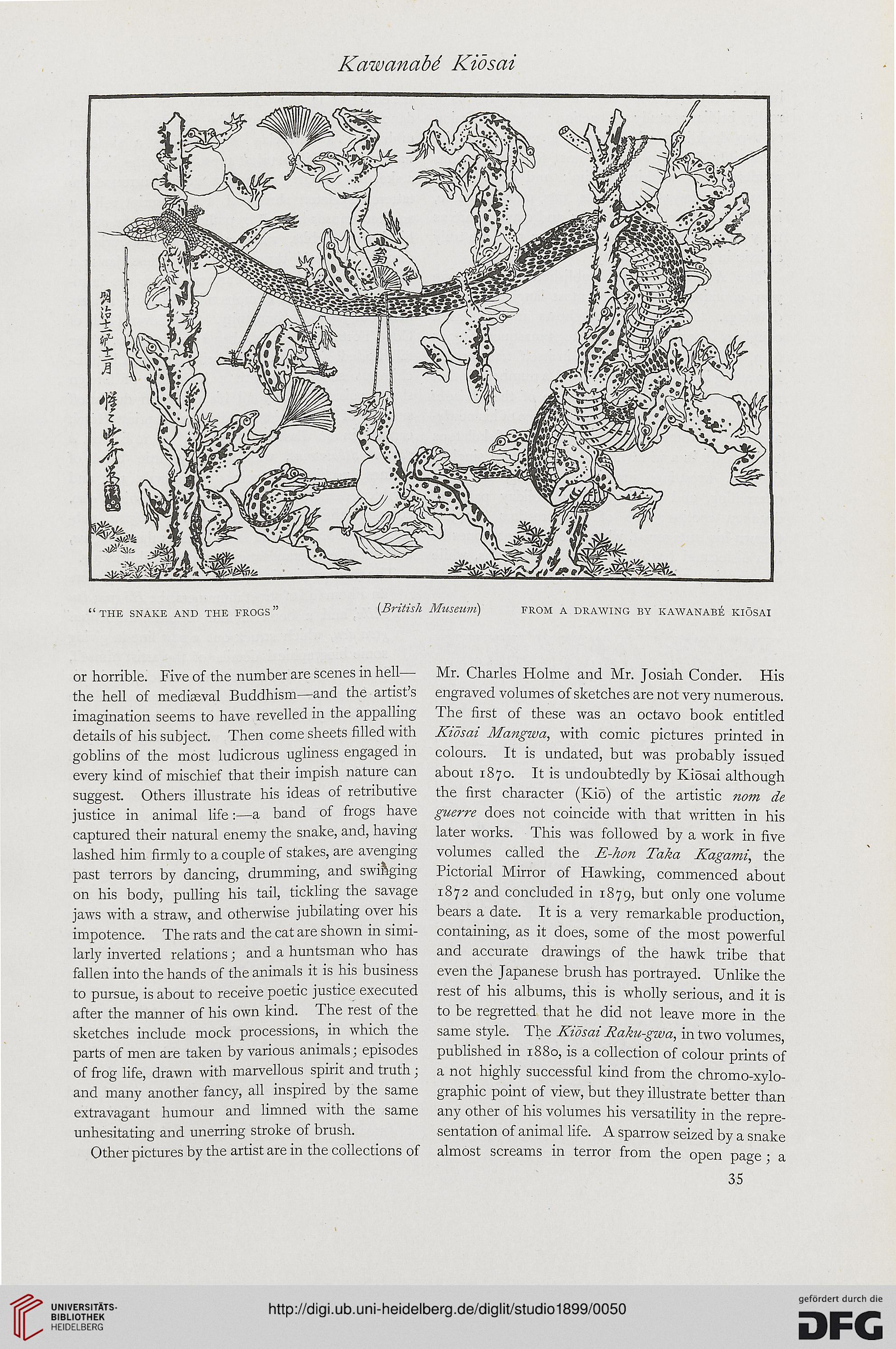Kawanabd Kidsai
or horrible. Five of the number are scenes in hell—
the hell of medieval Buddhism—and the artist's
imagination seems to have revelled in the appalling
details of his subject. Then come sheets filled with
goblins of the most ludicrous ugliness engaged in
every kind of mischief that their impish nature can
suggest. Others illustrate his ideas of retributive
justice in animal life:—a band of frogs have
captured their natural enemy the snake, and, having
lashed him firmly to a couple of stakes, are avenging
past terrors by dancing, drumming, and swinging
on his body, pulling his tail, tickling the savage
jaws with a straw, and otherwise jubilating over his
impotence. The rats and the cat are shown in simi-
larly inverted relations; and a huntsman who has
fallen into the hands of the animals it is his business
to pursue, is about to receive poetic justice executed
after the manner of his own kind. The rest of the
sketches include mock processions, in which the
parts of men are taken by various animals; episodes
of frog life, drawn with marvellous spirit and truth ;
and many another fancy, all inspired by the same
extravagant humour and limned with the same
unhesitating and unerring stroke of brush.
Other pictures by the artist are in the collections of
Mr. Charles Holme and Mr. Josiah Conder. His
engraved volumes of sketches are not very numerous.
The first of these was an octavo book entitled
Kidsai Mangwa, with comic pictures printed in
colours. It is undated, but was probably issued
about 1870. It is undoubtedly by Kiosai although
the first character (Kio) of the artistic nom de
guerre does not coincide with that written in his
later works. This was followed by a work in five
volumes called the E-hon Taka Kagami, the
Pictorial Mirror of Hawking, commenced about
1872 and concluded in 1879, but only one volume
bears a date. It is a very remarkable production,
containing, as it does, some of the most powerful
and accurate drawings of the hawk tribe that
even the Japanese brush has portrayed. Unlike the
rest of his albums, this is wholly serious, and it is
to be regretted that he did not leave more in the
same style. The Kiosai Raku-gwa, in two volumes,
published in 1880, is a collection of colour prints of
a not highly successful kind from the chromo-xylo-
graphic point of view, but they illustrate better than
any other of his volumes his versatility in the repre-
sentation of animal life. A sparrow seized by a snake
almost screams in terror from the open page ; a
35
or horrible. Five of the number are scenes in hell—
the hell of medieval Buddhism—and the artist's
imagination seems to have revelled in the appalling
details of his subject. Then come sheets filled with
goblins of the most ludicrous ugliness engaged in
every kind of mischief that their impish nature can
suggest. Others illustrate his ideas of retributive
justice in animal life:—a band of frogs have
captured their natural enemy the snake, and, having
lashed him firmly to a couple of stakes, are avenging
past terrors by dancing, drumming, and swinging
on his body, pulling his tail, tickling the savage
jaws with a straw, and otherwise jubilating over his
impotence. The rats and the cat are shown in simi-
larly inverted relations; and a huntsman who has
fallen into the hands of the animals it is his business
to pursue, is about to receive poetic justice executed
after the manner of his own kind. The rest of the
sketches include mock processions, in which the
parts of men are taken by various animals; episodes
of frog life, drawn with marvellous spirit and truth ;
and many another fancy, all inspired by the same
extravagant humour and limned with the same
unhesitating and unerring stroke of brush.
Other pictures by the artist are in the collections of
Mr. Charles Holme and Mr. Josiah Conder. His
engraved volumes of sketches are not very numerous.
The first of these was an octavo book entitled
Kidsai Mangwa, with comic pictures printed in
colours. It is undated, but was probably issued
about 1870. It is undoubtedly by Kiosai although
the first character (Kio) of the artistic nom de
guerre does not coincide with that written in his
later works. This was followed by a work in five
volumes called the E-hon Taka Kagami, the
Pictorial Mirror of Hawking, commenced about
1872 and concluded in 1879, but only one volume
bears a date. It is a very remarkable production,
containing, as it does, some of the most powerful
and accurate drawings of the hawk tribe that
even the Japanese brush has portrayed. Unlike the
rest of his albums, this is wholly serious, and it is
to be regretted that he did not leave more in the
same style. The Kiosai Raku-gwa, in two volumes,
published in 1880, is a collection of colour prints of
a not highly successful kind from the chromo-xylo-
graphic point of view, but they illustrate better than
any other of his volumes his versatility in the repre-
sentation of animal life. A sparrow seized by a snake
almost screams in terror from the open page ; a
35




